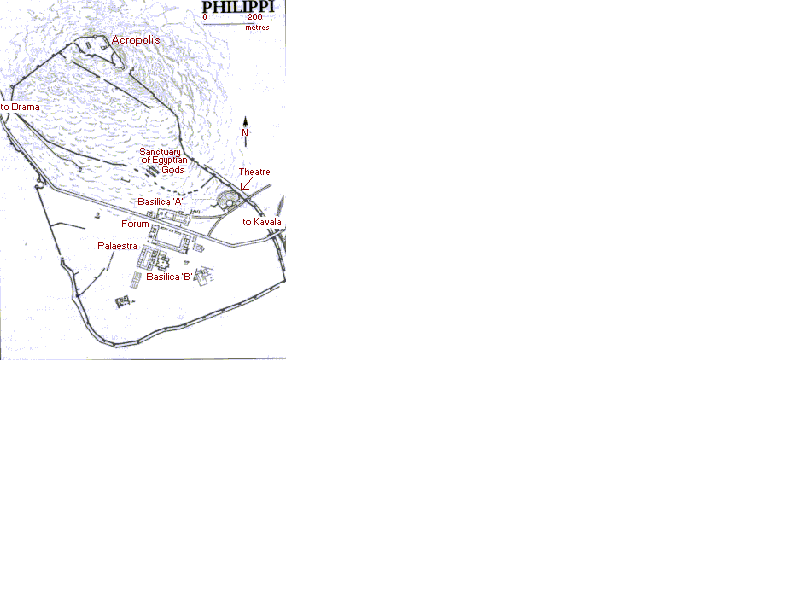|
Day one: |
|
|
Kavala - Filipi - Kavala |
|
|
|
|
|
After a good nights rest in hotel Lucy, we set out to visit the ancient city of Filipi. Situated on the ainroad from Kavala to Drama, this site is certainly worth the visit. Below we give a very brief history of the city. |
|
|
|
|
|
 |
|
|
Taken from Democritus University of Thrace
|
|
|
In the middle of the fourth century Bc in a fortified position between the ass of Mt. Orbilus and the marshes then covering the present-day coastal plain of Filipi, colonists from the island of Thasos led by the exiled Athenian orator and stateman Kallistratos founded Crenides, probably on the site of an earlier settlement |
|
|
In 356 bc King Philip II of Macedon conquered Amphipolis and began to extend his empire eastwards. He overran the Hellenic cities of Aegean Thrace, including Crenides. Recognising the strategic importance of this Thasian colony, King Philip fortified Crenides with a massive wall, settled new colonists and renamed the city Filipi. |
|
|
Very few remains of the Macedonia city of Filipi have as yet come to light. However, the city walls and the ancient theatre show traces of masonry from the earliest period of construction, dating back to the time of Philip II. Forming part of the kingdom of Macedon from this time up to its conquest by the romans (148 bc), the city of Filipi with its coastal port of Neapolis (Kavala) developed into an iportant urban centre of eastern Macedonia. |
|
|
During the early roman period (2nd century bc) the 'Via Egnatie' (Egnatian road), the great roan highway, passed within the city walls. |
|
|
 The First Roman Agora The First Roman Agora |
|
|
The city of Filipi flourished anew after the battle of Filipi (42 bc). The Roman senators Brutus and Cassius clashed on the plain of Filipi with Octavian (later Augustus Caesar) and Mark Antony. Despite their forces outnumbering Octavian's army and their better defensive position in the fortified acropolis of Filipi, Brutus and Cassius were defeated. The City now assumed special importance to the victors. Immediately after the battle Mark Antony settled the first roman veterans at Filipi. The reign of Augustus Caesar (Octavian) saw the building of the first roman agora (forum) and an ambitious building programme followed. In the period of the Antonine emperors (2nd century AD) the city aquired a new forum, the commercial agora, and the Palaestra, while its streets were paved and a drainage system laid down. The theatre was extensively renovated and enlarged. |
|
|
 The Theatre The Theatre |
|
|
Yet a third chapter in the history of Filipi was ushered in with the coming os St. Paul in 49 ad and the establishment of the first christian church in Europe. The Acts of the Apostles tell of the arrival of Paul in Filipi. Towards the middle of the fourth century ad, when christianity had become the official state religion, Bishop Porphyry built the first house of prayer, next to a pagan buriel heroon. Inscriptions on the mosaic floor inform us that this chapel was consecreated to St. Paul. |
|
|
Filipi prospered greatly during the 5th and 6th century as a place of pilgrimage associated with the memory and worship of St. Paul. This same period saw the building of such monumental churches as the Octagon Church, two Basilica and the cemetery chapels outside the eastern wall of the city, where the christian community had its burial ground. |
|
|
 The remains of Basilica B The remains of Basilica B |
|
|
The catastrophic earthquakes of the early seventh century, together with the incvasions by Slavs and Bulgars, brought destruction to the city and led to its gradual decline. During the Byzantine period it was mainly a fortified stronghold. Emperor Nicephoros Phocas (10th century) repaired and reinforced the walls and in the time of the Paleologues (14th century) the central fortress tower, which still comands the acropolis today, was built. |
|
|
After the Turkish conquest, the city and its fortifications were abandoned and fell into ruin. In 1914 the french Archaeological School began excavating the site of the ancient city of Filipi. These excavations continue today, carried out by the Hellenic Archaeological Service, the Archaeological Society of Athens and the University of Thessaloniki. |
|
|
All text taken from the 'Map of Filipi' which is available at ancient city of Filipi. |
|
|
|
|
|
As we said already, visiting Filipi is certainly worht it. Exhausted as we were from all the impressions, we decided not to visit Drama, but to return to Kavala and spend the rest of the day on the beach. After having enjoyed the sun and the warm water, we went out for something to eat and prepare for the next day. |
|
|
|
|
|
Day two: We travelled through the mountains from Kavala via Xanthi to Komotini. |
|



